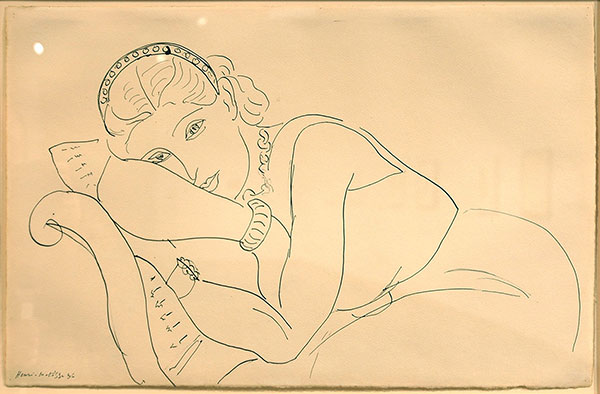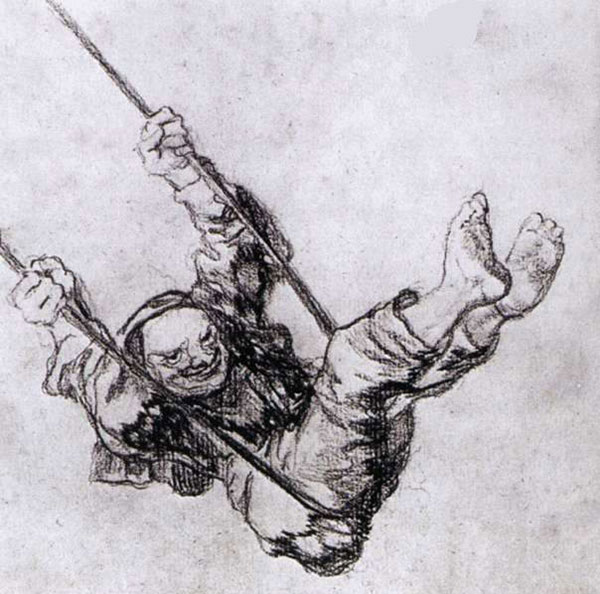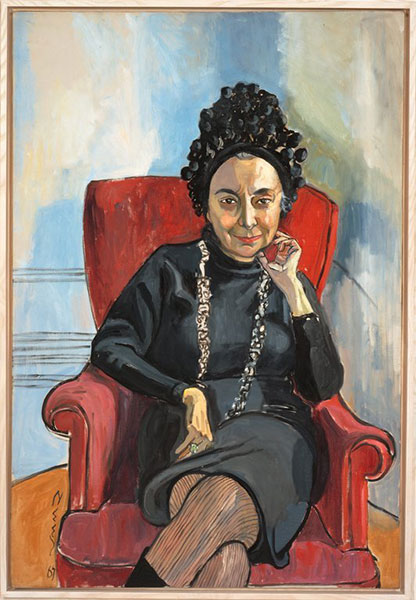
Andrea, 2012, by Fred Hatt
I try to put up at least one post a month based around my ongoing practice of drawing the human figure from life, and this is one of those posts. But instead of discussing drawing techniques or formal concerns, or relevant knowledge about anatomy or visual perception, I want to speak, as an artist, about our often unsung partners in this practice, the models. Beyond a statement of appreciation, I want to raise some questions that I hope will start a discussion, and I urge both models and artists to offer their thoughts. (The pictures are in random order and not directly related to the adjacent discussions. I’ll let the pictures speak for themselves.)

Kneeling Over, 2012, by Fred Hatt
Drawing the human figure from observation of the live nude model has been a staple of art schooling for centuries, and today open life drawing sessions are available in many places, so that a sort of subculture of the art world has arisen among artists who make a study of the human body the focus of their relaxation or their struggle. It’s a world beautifully described by naturalist and author Peter Steinhart in “The Undressed Art“, and it’s the world I fell into back in the mid-1990’s when I decided my creativity needed to be anchored to a regular discipline – a discipline I found at New York’s Spring Studio, which offered twenty open figure drawing sessions a week.
The human body and face contain as much depth as any creative subject one could choose. Studying the human animal, we are seeing ourselves, and all the wonderful variations Nature can work on a form. We are seeing energy and structure, power and vulnerability, character and emotion. In trying to depict what we see, we can challenge ourselves in the direction of spontaneity or refinement, speed or endurance, realism or abstraction, knowledge or pure impulse.

Bench, 2012, by Fred Hatt
While some artists think of the model as an object of study, fundamentally no different than a plaster cast or a bowl of fruit, I think most artists that devote themselves to the life drawing practice value it as an interactive experience. The model offers not only their body, but their attitude and their aliveness.

Pedro, 2012, by Fred Hatt
An artist’s style reflects her experience. The understanding of things like light and anatomy show her knowledge and her innate way of seeing. The quality of the marks show her energy and the particular quality of her movement. The model also shows his life experience. His body may be trained by dance or athletics, or it may show the marks of age or experience. His face and the poses he choose reveal something about his attitude and adaptation to the world.

Anguish, 2012, by Fred Hatt
Many of the professional artist’s models that work in the studios of New York are creative people in their own right. Some are dancers or actors, and they may approach the task of modeling as a performance. Others are writers or musicians, people with a rich interior life who appreciate a job where they can be still and quiet, composing in the mind. Others are lovers of art who find their own creative spark manifests most strongly in inspiring others with their presence and openness.

Double Back, 2012, by Fred Hatt
When I work with models privately in my own studio, I think of it as a kind of collaboration. I choose models that have an energy or style that I find exciting, and I try to allow them to manifest that style in a way that enters into my artwork. But even when drawing models in an open session with multiple artists, where the model chooses her own poses without any input from me (as is the case for all of the works pictured in this post), my drawings clearly draw a great deal from the model’s contribution to the experience.

Lie Down on Black, 2012, by Fred Hatt
Historically, artists have usually been of a relatively privileged class, while models were often prostitutes or laborers, exploited or objectified by the artists, and certainly never accorded any respect or credit by the art world arbiters who could elevate the artists to positions of fame and honor. The great model and writer Claudia (pictured below) has written many stories of historical artist/model relationships on her blog, Museworthy, and most of them are tragic tales.

Claudia, 2012, by Fred Hatt
I truly respect the models I work with. My work depends upon them completely. I have only been able to do what I do because these men and women have offered me the opportunity to “draw from” their bodies and their spirits. All of them have fed me, and the greatest of them have inspired me and prodded me to exceed my own limitations. In the best moments, I have gazed upon some of these models and felt what I can only describe as love, a rapture of being connected to another through the gaze.

Conversation, 2012, by Fred Hatt
In my intellectually formative years, feminists and cultural critics were offering a strong critique of the “male gaze” of figurative art, particularly the art of “the nude” as an act of objectification, an attempt by the male ruling class to claim ownership of the female, the cultural “other”, the working class. The sad history of the way so many artists treated their models certainly makes this more than just an abstract theoretical argument.

Vassilea, 2012, by Fred Hatt
I always felt, though, that there was something prudish in the condemnation of nude art. I loved the body and the tradition of the nude in art, which often expressed both eroticism and spirituality – a combination I found particularly compelling. So I was drawn to devote myself to the art of the nude. But as a white male, I felt I could not just ignore the critique of the “male gaze”. My solution was to attempt to depict the body not as an object, but as a pattern of living energy, and to treat my subjects not as ideals, but as individuals, with unique characters and authentic personhood. I would not look down upon my models from a position of power, I would look up at them with an attitude of adoration and wonder.

Sidewise, 2012, by Fred Hatt
When I work with models, privately or as the monitor (supervisor) of public sessions at Spring Studio, I try to treat them with respect and compassion. I’ve worked as an art model myself, so I know the pain and discomfort it can often involve, and the vulnerability that is inherent to getting naked before others and keeping still.

Head on Hand, 2012, by Fred Hatt
Many of the models I have drawn love to see my depictions of them, and I”ve always been willing to send images and even sometimes give drawings to models. I feel the models are my greatest fans – I’ve certainly received more praise and appreciation from models than I ever have from art world figures like dealers and critics. There is nothing sentimental or idealizing in my approach to drawing them. People who specialize in portrait commissions will complain of the vanity of their clients, but artists’ models don’t seem to have that kind of insecurity. The nature of the job pretty much requires you to give that up. Sometimes I feel I am doing the work for the models. I so appreciate the opportunity to look at them that I want to show them all the wonderfulness that I see in them.

Plans, 2012, by Fred Hatt
Still, they remain mostly anonymous. When I have a show, or even when I put drawings up here on the blog, I don’t individually credit the model for each work. Sometimes I talk about individual models, but often I don’t. I keep the models all mixed up, which keeps the focus on the artist. I’ve done that even in this post. I write the model’s name on the back of every drawing, but if it’s framed, no one sees it. Since I see work with models as essentially collaborative work, should I credit the models individually?
I also work as a photographer and have often attended the Photo Plus Expo, a trade show at the Javits Center in NYC, so I can check out all the amazing gear I can’t afford. The booths for major manufacturers like Fuji, Canon and Epson always feature big beautiful photographic prints, and I recall once, maybe a decade ago, seeing there a huge shot of my friend, performance artist Amy Shapiro. In the photo, Amy was wearing a fantastic costume she created, including a hat with live grass growing on it, and her face was decorated with a grassy paint motif by me. The picture was taken at one of the Earth Celebrations pageants, public celebrations with revelers costumed as nature spirits, that sought to save the endangered community gardens of Manhattan’s Lower East Side. The label of the photograph proudly credited the photographer, but there was no mention of Amy, me, Earth Celebrations, Felicia Young (Earth Celebrations’ director) or anything else. This photographer had just attended an event (one that attracted lots of photographers) and took a shot. Everything that made the shot interesting depended on others’ creativity, but they weren’t given their due. Seeing that made me conscious of how much photography really is about “taking”. There’s a bit of that in drawing, too.

Side Curve, 2012, by Fred Hatt
My friend Kristin, a dancer/choreographer, who has also been a creative collaborator of mine on video projects and has worked with me as an art model, recently sent me a link to this very interesting blog post (by Sarah Maxfield) with extensive discussion in the comments section. The beginning of the discussion here is about choreographers and photographers failing to credit dancers, but questions about artists’ models also arise in the discussion, as many dancers have done such work. The author and commenters really raise a lot of issues that are important, and rarely considered, and the level of the conversation will surely disabuse you of any notion that dancers are airhead bunheads.

James, 2012, by Fred Hatt
The currently prevailing convention in the subculture of life drawing sessions and classes, at least here in New York, seems to be that artists’ models go by first names only. They are generally listed that way on the model schedules, and if you ask a model’s name, you’re generally given just a first name. Many artists make recognizable portraits of professional artists’ models, and often title them with the model’s (first) name. I usually do that myself when the works are basically portraits – calling a portrait something else would seem an unwarranted judgment or definition of the person. But Minerva Durham, the director of Spring Studio, once criticized that practice. As I recall, her point was that the model is paid to let you use their body, not their identity.

Undresser, 2012, by Fred Hatt
I once worked with a female model who had been born in modesty-obsessed Afghanistan but grew up in body-positive Western Europe, who was upset that another artist from Spring Studio had posted online a portrait (not nude) of her tagged with her real name. She was afraid her Afghan relatives would find it and be upset. I suggested she should come up with a “nom de muse”. I suppose there are many reasons nude artists’ models (who often also have other careers) might want to remain anonymous, and if I don’t know, I hesitate to credit them all with full names.
A few years ago when I put up my current portfolio website, I emailed all the models I could to let them know I was putting drawings of them on my site, to thank them, and to ask them if they wished to be credited as model. I think only one model actually asked to be credited.

Lying Awake, 2012, by Fred Hatt
Here on Drawing Life, my usual practice has been to title drawings with the model’s professional first name when it’s a portrait, and to give drawings that are less specifically portraits descriptive or poetic titles. In this post, I’m crediting all the models with first names at the foot of the post.
I want to honor and thank the models that contribute so much to my work. I’m not sure how best to do that. I would love to get comments from artists or models about this issue. Let me know what you think and how you feel!
All the drawings above were done at open figure drawing sessions at Spring Studio in Manhattan or Figureworks Gallery in Brooklyn (where there is a current show drawn from 12 years of life drawing classes there, with two of my drawings included). All are in the size range between 18″ x 24″ and 19.5″ x 27.5″. Models and media for the above drawings are as follows. “Crayon” means Caran d’Ache aquarelle crayons. In case of mixed media, first listed is predominant.
Andrea, crayon and watercolor/gouache
Kneeling Over (Eric), crayon
Bench (Claudia), watercolor/gouache
Pedro, watercolor/gouache and crayon
Anguish (Eric), crayon
Double Back (Claire), watercolor
Lie Down (Amy), crayon
Claudia, watercolor
Conversation (Eric), watercolor/gouache
Vassilea, watercolor/gouache
Sidewise (Adam), watercolor/gouache
Head on Hand (Amy), watercolor
Plans (Adam), crayon
Side Curve (Amy), crayon
James, watercolor/gouache and crayon
Undresser (Adam), watercolor
Lying Awake (Claudia), crayon



































































































